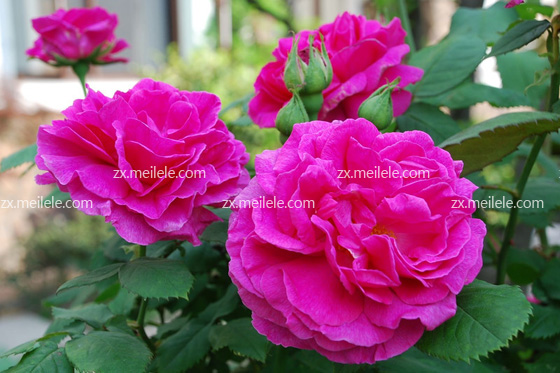Have you ever heard of Fujimoto rose?
Fujimoto rose belongs to the rose family, we all know that rose belongs to climbing plants, and the rattan rose introduced to you today is a hybrid of rose and climbing vines. It has a small stem with small spines. Through fine cultivation and pruning, it can be in the shape of rattan or climbing. It blossoms in midsummer and has a strong fragrance. Good varieties can blossom again in autumn.

Next, the editor will share with you the variety classification and some pictures of Fujimoto rose.
Upright (shrubby)
The upright type of Fujimoto rose is literally upright, with only one trunk. During the period of hybridization, by means of cultivation, its genes mainly tend to the parent rose, while the branches and leaves tend to hybrid plants. Therefore, the upright type of rattan rose is more like that of Chinese rose in shape, but during the growth period, the branches and leaves are not as broad and dense as the parent rose, and the flowers are not as large as the parent rose.

Climbing type (trailing)
Climbing rattan rose is often planted in the corner of the wall and looks very much like a rose from a distance. The most important feature of climbing rose is its dense flowers. When this kind of rattan rose is cultivated, it will be cultivated by climbing plants such as Parthenocissus. Therefore, the selection of gene cultivation is more inclined to climbing type. At the height of summer, climbing vines climb upward along dependent walls or through artificial guidance this season.
Natural original species
After years of artificial cultivation, Fujimoto rose has taken root and sprouted in the wild. The natural original species is one of the representatives, the natural original species is rose in the wild, through continuous growth, and other plants were combined, the shape is low, but the flowers grow fast and the florescence is longer.

Like other ornamental plants, Fujimoto rose needs to be pruned to achieve the purpose of beauty. The erect rattan rose needs to be pruned in autumn or spring when the flowers are withering, mainly according to the shape of the whole plant. The climbing rattan rose needs to be pruned after the flowers and leaves have withered in late autumn and re-cut when the new leaves sprout in spring.

Conclusion: the flower phrase of Fujimoto rose-"the beauty of danger", the flowers are accompanied by spikes, beauty and danger. Isn't it very special? The editor has finished the introduction to everyone, through the introduction of the editor, whether you have a certain understanding of Fujimoto rose. The magic of nature is to give you beautiful things and feelings. Today, do you prefer the upright Fujimoto rose, or the enchanting climbing Fujimoto rose?
- Prev

How to put the wealth tree and the matters needing attention in the cultivation of the wealth tree
How to put the wealth tree and the matters needing attention in the cultivation of the wealth tree
- Next

Wild chrysanthemum picture, what is the function of wild chrysanthemum?
Wild chrysanthemum picture, what is the function of wild chrysanthemum?
Related
- Wuhan Hospital Iron Tree Blooming Result Was Instantly Frightened by the Gardener Master
- Which variety of camellia is the most fragrant and best? Which one do you like best?
- What is the small blue coat, the breeding methods and matters needing attention of the succulent plant
- Dormancy time and maintenance management of succulent plants during dormancy
- Minas succulent how to raise, Minas succulent plant pictures
- What are the varieties of winter succulent plants
- How to raise succulent plants in twelve rolls? let's take a look at some experience of breeding twelve rolls.
- Attention should be paid to water control for succulent plants during dormant period (winter and summer)
- Watering experience of twelve rolls of succulent plants
- Techniques for fertilizing succulent plants. An article will let you know how to fertilize succulent plants.

